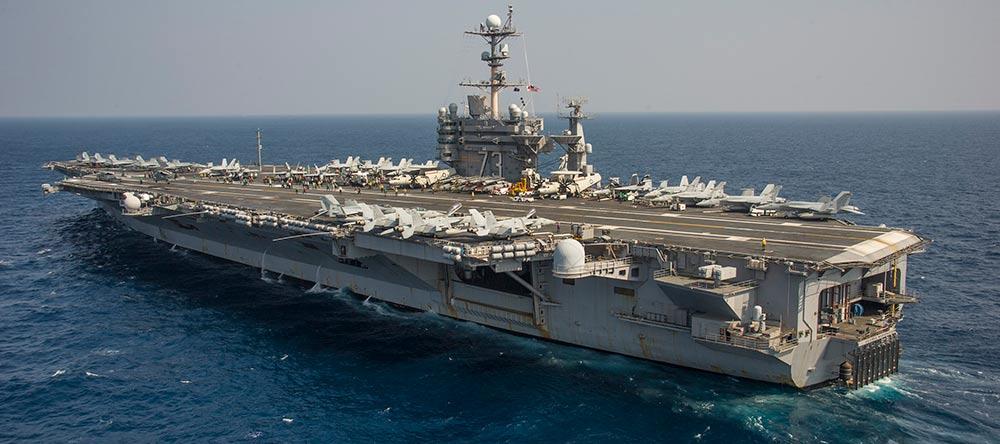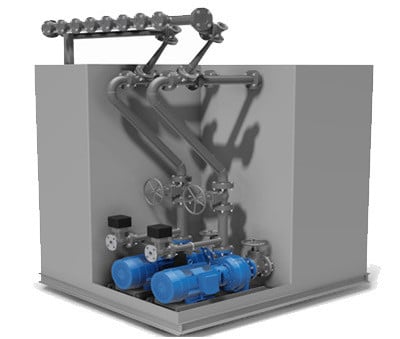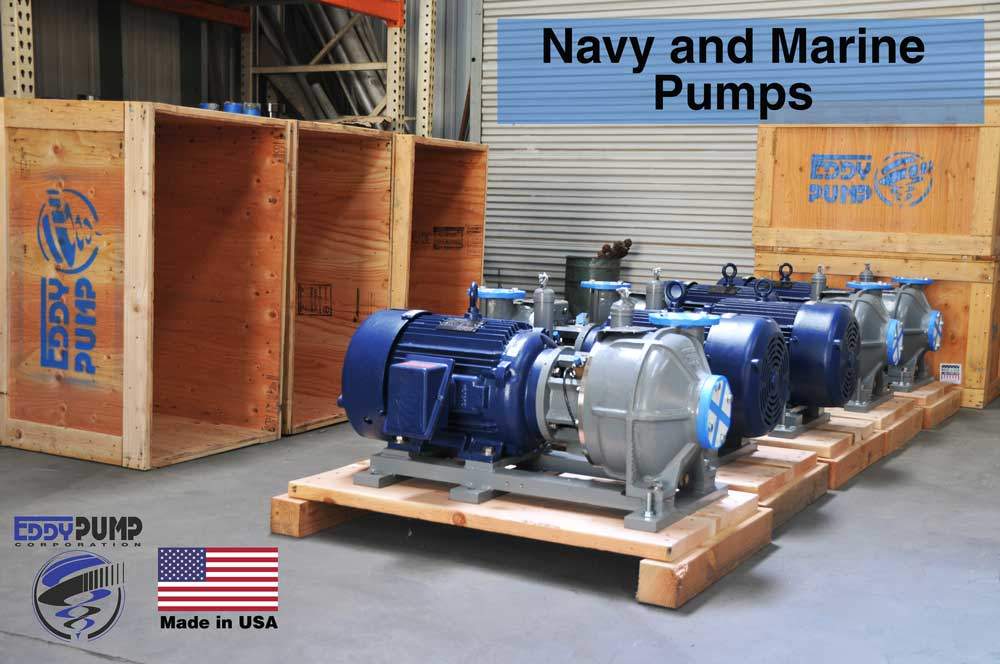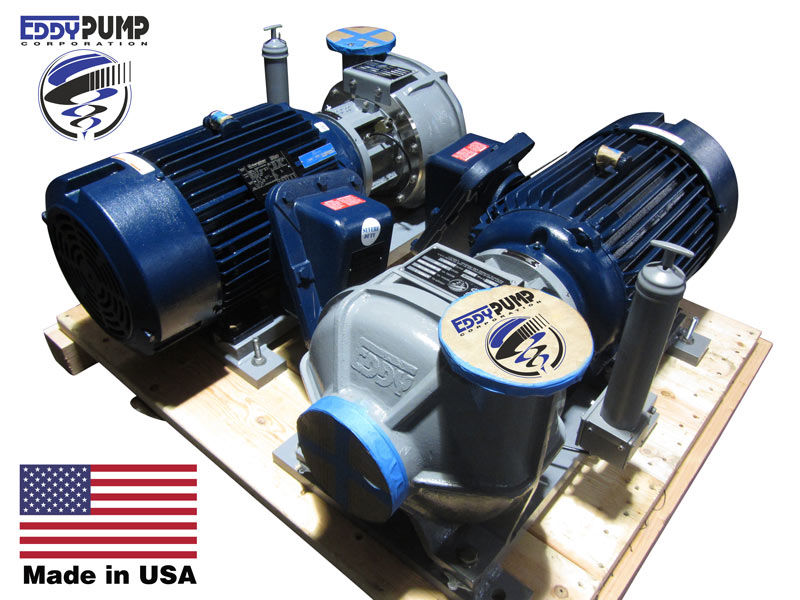“Fleet Maintenance Symposium 2009”
Achieving the Quest for Zero Maintenance
Tornado Principle Eddy Effect EDDY PUMP Systems at Fifteen Years

Since 1994, the tornado principle Eddy Effect EDDY Pump System has been installed on CVs, CVNs, LHAs, LHDs, LCCs, LPDs, LSDs, CG-47s, AGFs and MSC in various sizes, configurations and applications. The transformational tornado principle of the EDDY Pump System has been proven in these applications to vastly exceed the performance and reliability of the centrifugal pumps which they replaced.
Prior to EDDY PUMP System installation, ships had been experiencing centrifugal pump failure rates just weeks to months after installation and dealing with the maintenance actions caused by seal leakage and spraying. Since installing the EDDY PUMP System, ships have experienced multi-year, trouble-free, minimal maintenance, zero-leak operation. Our earliest installations, in 1994, on CVNs have been trouble free for over fifteen years. Due in part to our unique ZeroLeak™ seal developed in accordance with the EDDY Pump System’s transformational tornado principle.
Previous papers on the EDDY PUMP System have been presented at ASNE events, the 1995 Fleet Maintenance Symposium, ASNE Day 2000, and published for ASNE Day 2005. From 1994 to 2000, approximately a hundred pump systems were installed on CVs and CVNs. Since 2000, over 300 hundred installations have been made on other ship classes. This paper provides an updated status report on fleet installations, including operating results and impact on system maintenance since the ASNE Day 2005 paper.
System Design
The EDDY Pump operates on the tornado principle, not the centrifugal principle. It is not a centrifugal pump or a vortex pump variant. The patented and proven design creates and harnesses a dynamic tornado and fluid eddy effect within the pump housing and inlet. This effect is similar to that which occurs in a tornado.
The tornado generates a high velocity rotating air mass with a central column of increasingly higher pressure reaching toward the ground, surrounded by peripheral low-pressure eddies. As the lower tip of the tornado touches down on the ground, objects are drawn into the low-pressure peripheral eddy. This effect enables the tornado to pulverize, pick up and carry objects into the rotating air masses.
Likewise, in the EDDY Pump, a very strong, synchronized central column flow develops from the pump rotor to the pump inlet and creates a low-pressure reverse eddy flow from the pump inlet to the pump discharge. This action also results in a region of negative pressure in the vicinity of the pump seal. The negative pressure enables the pump to achieve zero leakage with a very simple seal design. The seal design allows one-way passage of externally supplied low-pressure air through the shaft seal toward the pump casing (volute) to oppose the ingress of the material being pumped.
EDDY Pump Components
Dr. Harry Weinrib, the inventor of the EDDY Pump, describes the operation of the tornado principle EDDY Pump as follows:

TORNADO PRINCIPLE PUMP VS. CENTRIFUGAL PRINCIPLE PUMP
Most conventional centrifugal-type impellers incorporate front and back shroud enclosed vanes and a center suction “eye” configuration. They discharge the solids by centrifugal force. In order to prevent fluid recirculation, critical tolerances are necessary between the wetted parts of the pumps. As wear occurs, these critical tolerances increase and the pumps progressively lose their hydrodynamic efficiency. The only way to keep these pumps functioning at an acceptable level of performance is to replace the various components based on a regular maintenance program.
Vortex type pumps are conventional centrifugal pumps with the suction end of the impeller shroud removed to expose the vanes. This type of impeller configuration enables the pump to create a unidirectional swirling column of liquid (vortex) in addition to the centrifugal force. The turbulence created within the suction opening draws the material into the low-pressure area within the pump casing and discharges it by centrifugal force.
The EDDY Pump rotor uses an open cruciform configuration without any impeller shrouds. When in motion, it contains and re-circulates an axially solid, progressively concentrated nucleus of energy. This energy is released in the form of a synchronized swirling column transmitted to the center of the pump intake opening by creating a negative pressure, or “eddy” effect, in the intake throat area. This “eddy” current carries the material along the low-pressure periphery of the swirling column of fluid to the discharge. Table 1 compares characteristics of the tornado principle EDDY Pump versus the centrifugal principle pump.
EDDY Pumps incorporate a “pull back” design to allow minor and major overhauls without removing the pump from the space in which it is installed. The motor, bearing house (or connector), shaft and rotor “pull back” from the volute. The intake and discharge piping do not need to be disconnected. Pumps installed in a vertical position have a telescoping frame with jacking points to facilitate this procedure.
System Installations
With the implementation of the EDDY Pump System, maintenance costs for the CHT / VCHT and Brine pump applications have been greatly reduced. The cost savings are effective on a ship’s deployment (real-time) and life cycle due to the:
- Multi-year longevity of the non-mechanical pump seal
- Non-casualty pump status
- Pump seal’s low air pressure
- Automatically controlled pump seal greaser
- Pump motor controllers
- Extremely low PMS requirements
- Pump’s natural ability to create flow using the material being pumped.
With the EDDY Pump, the creation of flow using the material is very different from all other pumping methods. This is key to the longevity and lack of wear of the pump components. It also provides a very strong suction lift and effective discharge pumping over variable and or steady discharge head pressures and varying material viscosities while in operation. With the reverse tornado and eddy effect created inside the pump volute, the material, even if very abrasive or a solid object, is cradled in the flow effect and carried out. Due to this, the material being pumped does not get the chance to rub against the pump’s internal components, creating less wear over long periods of time. To the EDDY Pump company’s knowledge, an EDDY Pump has never been discarded or fully replaced. There have been a few pump components here and there over the past fifteen years, and pump seal changes at an average of 3-5 years per pump.
Brine Applications
The CC-6000 EDDY Pump has been developed for brine, seawater and feed pump applications. Since 1999, the CC-6000 L-class 6-inch suction / 7-inch discharge, 40 HP motor brine pump has been used for LHD-3 brine applications. Since installing the EDDY Pump brine pump, the ships have had zero downtime and continuous operation and or readiness with only two seal changes while in port. The motor requires no PMS for the pump seal because it is marine-duty sealed and uses auto-greasers. Because of the LP-air to the seal and its internal design, there has been no leakage of brine fluid at any time. Please refer to previous ANSE papers on the CVN Brine pump test and life cycle cost savings.
CHT/VCHT Applications
The NF-4000 is currently used for CHT and VCHT discharge applications. It is installed on all CV, CVN and large L-class ships. The NF-4000 features a 5-inch suction / 4-inch discharge, 40 HP motor and has been in service on the US Navy fleet for fifteen years.
The CC-3000 is currently used for CHT and VCHT discharge applications on all L-class ships, new LPD-class and the VC/MDS system on CVN-77 and CVN-78. The CC-3000 features a 3-inch suction / 3-inch discharge and a 20 or 30 HP motor. As of 2009, 8 of the 22 CG-47 class ships have had the CC-3000 installed as part of the HM&E upgrade package. The installation has begun on the MSC submarine tenders as of mid-2009.
The CC-2000 pump is currently designed in for the MSC T-AKE MSD CHT system in place of the existing submersible pumps with built-in grinders. The pump features a 2- or 3- inch suction / 1.5 or 2-inch discharge and a 10 HP motor.
The CC-3000 is currently used for CHT and VCHT discharge applications on all L-class ships, new LPD-class and the VC/MDS system on CVN-77 and CVN-78. The CC-3000 features a 3-inch suction / 3-inch discharge and a 20 or 30 HP motor. As of 2009, 8 of the 22 CG-47 class ships have had the CC-3000 installed as part of the HM&E upgrade package. The installation has begun on the MSC submarine tenders as of mid-2009.
The CC-2000 pump is currently designed in for the MSC T-AKE MSD CHT system in place of the existing submersible pumps with built-in grinders. The pump features a 2- or 3- inch suction / 1.5 or 2-inch discharge and a 10 HP motor.
The Below Chart Shows the Current EDDY Pumps Approved for Installation:
| CC‐6000 Brine Pump |
|
| CC-2000 |
|
| CC-3000 CHT Pump |
|
| NF-4000 CHT Pump |
|
NOTE: All Eddy Pumps can change PSI and GPM with a motor and/or rotor change. The Eddy Pump is designed for use in any application that requires pumping any fluid with or without suspended solids, sea salts, barnacles, small sea creatures, light or heavy slurry and abrasive material.
Cost Savings Comparisons
The system, as currently designed, has held up very well in arduous environments. Corrective and planned maintenance data for seven aircraft carriers collected on the EDDY Pump to May of 1998 was compared to corrective and planned maintenance data for the previously installed centrifugal pump. The comparison shows that the installation of the EDDY Pump would provide life cycle savings of $3,000,000 per ship. The comparisons are still valid as of 2009. Please refer to previous ANSE papers for analysis data.
In 2007, a life cycle cost analysis was done for 25 of the USCG ships, comparing their current pump versus an EDDY Pump. An estimated $17,717,000 in savings was discovered. Much of these savings are related to the absence of overhauling costs associated with the EDDY Pump, along with the minimal corrective maintenance costs.
The table shows the maintenance and overhaul of the EDDY Pumps along with dates and reasons:
| Pump Type | Ship | Date Pump Built | First Repair | Overhaul Date | Cause |
|---|---|---|---|---|---|
| CC-3000 | LHD-2 | 1/20/2000 | 10/6/2003 | N/A | Normal Wear |
| CC-3000 | LHD-2 | 1/20/2000 | 3/18/2007 | N/A | Normal Wear (Worn Seal) |
| CC-3000 | LPD-17 | 10/14/2004 | None | N/A | N/A |
| CC-3000 | LPD-7 | 3/11/2002 | 2/17/2006 | N/A | Normal Wear (Worn Seal) |
| CC-3000 | LHD-9 | 8/11/2004 | 3/14/2008 | N/A | Normal Wear (Worn Seal) |
| CC-3000 | LSD-51 | 7/6/2002 | 11/15/2007 | N/A | Normal Wear (Worn Seal) |
| CC-3000 | LSD-51 | 7/6/2002 | 3/11/2008 | N/A | Seal worn due to air shut-off to auto greaser |
| NF-4000 | CVN-70 | 7/17/1997 | 5/18/2002 | N/A | Normal Wear (Worn Seal) |
| NF-4000 | CVN-70 | 7/17/1997 | 5/18/2002 | 1/29/2007 | Ship in Shipyard |
| NF-4000 | CVN-69 | 3/15/1996 | N/A | 9/30/2002 | Ship in Shipyard |
| NF-4000 | CVN-69 | 3/15/1996 | 8/12/2008 | N/A | Normal Wear (Worn Seal) |
| NF-4000 | CVN-67 | 11/14/1997 | N/A | 10/2/2003 | Ship in Shipyard |
| NF-4000 | CVN-76 | 9/8/1996 | 7/18/2002 | N/A | Normal Wear (Worn Seal) |
| NF-4000 | CVN-76 | 9/8/1996 | N/A | 8/16/2007 | Ship in Shipyard |
| NF-4000 | LHA-2 | 4/11/2001 | 2/9/2006 | N/A | Normal Wear (Worn Seal) |
| NF-4000 | LHA-3 | 3/17/2001 | 5/16/2005 | N/A | Normal Wear (Worn Seal) |
Maintenance Issues and Solutions
1. We had recommended a seal change on a ship due to the CFM level detected on the controller from the pump. It was scheduled for the following week. It should be noted that s the pump seal will not prevent the operator from pumping, even with a worn seal. It just needs a manual prime. A tech. rep. was called in at 7:00 am Sunday morning to perform a seal change assist because the tank was full and the level was not going down. This was basically an emergency condition and all ship’s force was onboard. The DCA mentioned the pump had been running since the previous night for about 7 hours straight, still with no tank level reduction. It was thought that, since the pump needed a seal change, the pump was not actually pumping the fluid. This was not an accurate assessment, due to the design of the pump and pump seal. Once ship’s force could see that the pump had been operational the entire time, they discovered a pressure relief valve was broken and shooting fire main into the tank at an alarming rate causing the tank to fill up in spite of the pump working correctly. Once the relief valve was secured, the tank level immediately went down.
2. Pump room flooding occurs from time to time. The EDDY Pumps have performed according to the customer contract specifications even when the pump has been flooded. It has been reported by ship’s force a few times that rinsing the motor or rewinding it, reconnecting it to the pump and pumping away without any maintenance to the pump is common with the EDDY Pumps. These procedures greatly reduce maintenance issues during deployment. Most of the time the auto-greaser cartridge is replaced and any water damage to the seal grease from flooding is pushed out with new grease. This keeps the seal from wearing even after flooding the pumps. Another situation involved a CG-47 class ship flooding the pump room up to the pumps with fresh water. The room was drained, the motors were dried off with a heat gun and the EDDY Pump Tech rep was called in to inspect the system. The seals were fine and the recommendation was made to replace the auto-greaser mechanism and replace the grease tubes. To EDDY Pumps knowledge, the only maintenance done was the replacement of the auto-greaser tubes by the tech rep at no cost. This was 1.5 years ago as of 06/2009. No seal changes have been needed yet.
3. Just two years after OP testing a CG-47 class ship, we were called in to troubleshoot the system since the original HTs that were trained were no longer on board, due to large crew turnover. Although there have been no seal changes to EDDY Pumps knowledge on a CG-47 since the original install 3 years prior, this ship needed two seal changes in the AUX2 pump room. Why was a seal change needed so soon? After an inspection, it was noticed that the original auto greaser cartridges were still installed and never replaced, as they should have been, every 5 to 6 months. The auto greaser and the pump seal were empty and dry.
This is why the seals needed to be changed out; no grease for over a year!
4. Too much back-pressure was being created on one of the pumps on an L-class ship. The controller correctly kept going into an under the current condition to protect the pump and motor from any damage. It was discovered that a mechanical wrench was pumped through the pump and got stuck in the discharge’s 90 deg piping elbow. Once removed, the issue was resolved. No repairs were needed to the pump and no seal change was needed.
5. After a long deployment, a CVN class ship cleaned out their tanks. According to the HTs, the amount of left- over material inside the tank was unusually light: one trash can of left-over material compared to five before the EDDY Pumps were installed. This is due to the very strong suction vacuum pressure that the EDDY Pumps creates while the material gets sucked into the pump volute and discharged out. The more the material or object weighs, the more it is drawn to the pump, this is partly why objects such as tools and personal items get stuck in the discharge piping elbows.
6. OEM training onboard with ship’s force is mutually beneficial. EDDY Pump takes pride in offering complimentary visits to the US Navy ships back from deployment depending on time and availability. A technical rep visits the ship, goes to the pump rooms and provides a system-wide check of the pumps, controllers and valves, answers any questions, goes over the system for new sailors and changes out the grease cartridges. Typically, the technical rep observes ship’s force maintenance procedures, then, sends an observation and condition report to the ship and the ships PE. This assists ship’s force with a detailed and current understanding of the EDDY Pump system, troubleshooting, if needed, and the integration of the system into their ship’s tanks, TLI and piping system. With crew changes and the need for more “Manned Hours availability”, the complimentary visits are further reducing the life cycle and real-time deployment maintenance costs.
Performance Improvements
The EDDY Pumps pump design has not changed since its introduction to the US Navy fleet fifteen years ago. The pump continues to be applied to new pump applications using the original design. Two major upgrades have been made since the introduction of the pumps:
- Automated Controllers (PLC)
- Auto-Greasers
These were designed and implemented to support “Smart Ship” controls, intuitiveness of the system, and intelligent alarms for better operator knowledge of a pumping issue in real-time. The upgrades have assisted in creating less “Manned Hours” needed per pump system.
Automated Controllers (PLC)
Using automated controllers provides adaptability and easier integration into the ship’s control and monitoring systems while providing intelligent control functions and customization if necessary. Utilizing the intelligence of the controller has allowed ship’s force to better troubleshoot their EDDY Pump system in real-time operating format. Aside from redundant alarms to monitor correct operational set points, the controllers, new and old, monitor the pump motors amperage performance. With an EDDY Pump, no pump flow equals to low motor amperage. Low motor amperage will enable the Under-Current alarm. This gives the operator a real-time indication that the pump is not moving the fluid, and takes the guesswork out of wondering if the fluid is pumping or not. This is especially helpful when the ship’s PSI suction and discharge gauges are not working. Keep in mind that the EDDY Pump’s special ability to pump the material or fluid couples well with the motor amperage. Whether the tank is empty, suction pipe is plugged or starved, discharge pipe is plugged or deadheaded, a valve is closed or a pier side connection is kinked or plugged, the controller will detect this, protect the pump and motor by shutting off, and indicate an alarm locally or remotely to the operator for immediate attention. If the operator gets an Under-Current alarm, he is trained to check the priming of the pump, the tank level, the alignment of the valves, pier side connections, suction and discharge PSI gauges to determine if it is a suction (vacuum) or discharge (head pressure) issue, depending on the gauge indications. This has greatly reduced the number of manned hours needed to troubleshoot the system and ships piping.
Auto-Greaser
The auto greaser is a significant upgrade since it can reduce maintenance hours over a long period of time. EDDY Pump’s auto-greaser is very efficient in providing lubrication to the pump seal. Every 72 hours the controller will automatically grease the pump seal. This releases the operator from having to take the time to grease the seal during the entire deployment. The auto greaser grease comes in a tube type format and is changed out at an average of 5 to 6 months by just replacing the tube of grease; it uses the same process as a standard grease gun. No hand packing is needed, so it is very clean and quick to do, especially compared with all other centrifugal and non-centrifugal pump seal-lubricating methods.
Conclusion
In conclusion, the EDDY Pumps were designed fifteen years ago to meet the US Navy’s requirements for superior performance over a long life cycle – deployment after deployment, year after year. The EDDY Pumps for US Navy ships ensure cost savings by requiring less maintenance, low or no spare parts procurement and storage on the ship, fewer man-hours to service or operate the system, and minimal, deployment-long PMS. The EDDY Pump has proven to be extremely reliable, providing the assurance and peace of mind that the pump will get the job done and assist our sailors in keeping our country safe.
Related Products
HD (Heavy Duty) Slurry Pumps
Why EDDY Pumps Are Better – Highlights
This video shows how EDDY Pump transports high slurry and abrasive materials. Featured dredge pump equipment includes the Remote Operated Subdredge, Diver Operated Pump and a Excavator Attachment Dredge Pump.
Order or Get Selection Help
Let our sales or engineering support help in your grit pump and wastewater equipment selection. Call (619) 258-7020





